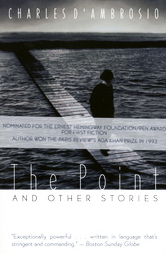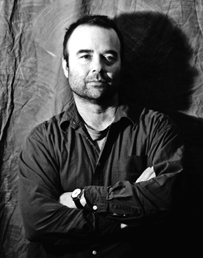 “The Point” is one of the first stories I ever remember remembering. A handful of years after it appeared in Best American Short Stories 1991 and served as the title story for Charles D’Ambrosio’s debut collection in 1995, I encountered it in a college fiction-writing class I was taking for fun while I hurtled toward my journalism degree. “The Point” was at the end of some chapter about some craft element it was supposed to exemplify. I don’t remember which. I don’t remember discussing the story in class. I don’t even remember reading it. But I remember the year after I’d graduated, after I’d decided I preferred waiting tables over newspaper reporting, being so haunted and enchanted by its final image that I had to dig up the old textbook and read it again.
“The Point” is one of the first stories I ever remember remembering. A handful of years after it appeared in Best American Short Stories 1991 and served as the title story for Charles D’Ambrosio’s debut collection in 1995, I encountered it in a college fiction-writing class I was taking for fun while I hurtled toward my journalism degree. “The Point” was at the end of some chapter about some craft element it was supposed to exemplify. I don’t remember which. I don’t remember discussing the story in class. I don’t even remember reading it. But I remember the year after I’d graduated, after I’d decided I preferred waiting tables over newspaper reporting, being so haunted and enchanted by its final image that I had to dig up the old textbook and read it again.
The story is about a thirteen-year-old boy, Kurt, who is charged with escorting home a drunk middle-aged woman, Mrs. Gurney, after his mother’s final summer party in a coastal community known as the Point. As he walks her along the moonlit beach, her drunken behavior impedes their progress more and more, and Kurt glimpses the various personal and existential crises she’s facing. This adds humor, as when, for instance, Mrs. Gurney, lying on her back, shirtless, begins packing wet sand onto her chest, but it also accesses the deeper layers in Kurt’s story. The job of escorting drunks to their homes was originally given to Kurt by his father, who has since killed himself. Because of this, Kurt takes his mission with Mrs. Gurney very seriously, and he’s sensitive to the desperation she and other adults seem barely able to conceal, a theme that gives the story’s final image its knee-buckling power.
 I’m not going to tell you what the image is, not because I think it would spoil the story for those of you who haven’t yet read it, but because the image loses its depth without the rest of the story behind it. “The Point” does everything stories are supposed to, and many things they aren’t. It begins with a dream, for example, and ends with backstory, both big violations of craft and yet somehow perfect. I could go on about the wonderful voice, the nighttime chiaroscuro, the rich and resonant detail, the sharply drawn characters, the increments of plot, the firm but subtle developments of theme. These elements are what infuse the image with its sharpness and complexity—its beauty comes from the way it extends and embodies them. That’s probably the reason it burns in my memory even now, so much that when I paused to consider which story to celebrate here, of all the hundreds I love, that image was what came rushing to my mind. But ripping the image from those other elements to show you its beauty is a little like beheading someone to show off his handsome face. So I’ll leave you to discover it on your own, and see how much like a beheading it really is.
I’m not going to tell you what the image is, not because I think it would spoil the story for those of you who haven’t yet read it, but because the image loses its depth without the rest of the story behind it. “The Point” does everything stories are supposed to, and many things they aren’t. It begins with a dream, for example, and ends with backstory, both big violations of craft and yet somehow perfect. I could go on about the wonderful voice, the nighttime chiaroscuro, the rich and resonant detail, the sharply drawn characters, the increments of plot, the firm but subtle developments of theme. These elements are what infuse the image with its sharpness and complexity—its beauty comes from the way it extends and embodies them. That’s probably the reason it burns in my memory even now, so much that when I paused to consider which story to celebrate here, of all the hundreds I love, that image was what came rushing to my mind. But ripping the image from those other elements to show you its beauty is a little like beheading someone to show off his handsome face. So I’ll leave you to discover it on your own, and see how much like a beheading it really is.
Note: You can hear Matthew Klam read “The Point” on The New Yorker‘s fiction podcast here.





